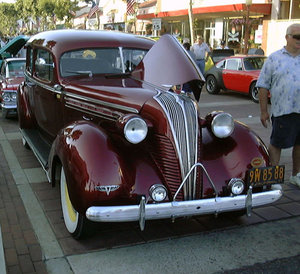Hudson Motor Car
|
|
HudsonAuto.jpg
1950_Hudson.jpg
The Hudson Motor Car Company made Hudson brand automobiles in Detroit, Michigan, from 1909 to 1957.
In 1919 Hudson introduced the Essex brand line of automobiles; the line originally was Hudson's line for middle class auto buyers, designed to compete with Ford and Chevrolet, as opposed to the more up-scale Hudson line.
One of Hudson's most famous cars was the Terraplane produced between 1932 and 1938, first as Essex-Terraplane in 1932-1933, and then as Terraplane until 1938.
The company had a number of 'firsts' for the auto industry. These included the self starter, dual brakes, and the first balanced crankshaft, which allowed the Hudson straight-6 engine to work at a higher rotational speed while remaining smooth, developing more power than lower-revving engines. Most Hudsons had straight-6 engines.
At its peak in 1929, 300,000 cars were produced in one year - Hudson and Essex combined - including contributions from Hudson's other factories in Belgium, England and Canada.
Hudson ceased auto production from 1942 until 1945 in order to manufacture war materials during World War II, including aircraft parts and naval engines.
After the war, Hudson initially did quite well, and their late-1940s low and rounded "step-down" styling, which lasted through the 1954 model year, was ahead of its time when introduced, and quite aerodynamic for the era. This, the Hudson's light weight, and its well-built engine made the sportiest model, the Hudson Hornet, a successful auto racing contender, dominating NASCAR in 1951, 1952 and 1953. Later, these cars met with some success in drag racing, where their high power-to-weight ratio worked to their advantage.
Like many other smaller North American auto manufacturers, Hudson found it increasingly difficult to compete with the Big Three (Ford, GM and Chrysler) during the 1950s. Those large companies could afford constant development and styling changes, so that their cars looked fresh every year (even if less changed beneath the surface), whereas the smaller manufacturers could only afford gradual change. They could not keep up with the churning of automotive fashion, and sales slipped. Merger was seen as the only way to survive at all, even if much of the individual makers' character would be lost.
On January 14, 1954, Hudson merged with Nash Motors to become American Motors. The Hudson factory was closed, and the remaining years of Hudson production consisted essentially of Nash cars with Hudson badging, dubbed "Hashes" by some.
The brand name was discontinued at the end of the 1957 production year.
1917.hudson.phaeton.arp.jpg
See also
External links
- Hudson-Essex-Terraplane Club (http://www.hudsonclub.org/)
- Hudson-Essex-Terraplane Historical Society (http://www.hudsonclub.org/hethist/hethisthome.htm)
- Hudson group on msn.com (http://groups.msn.com/HudsonMotorCarCompany/)

